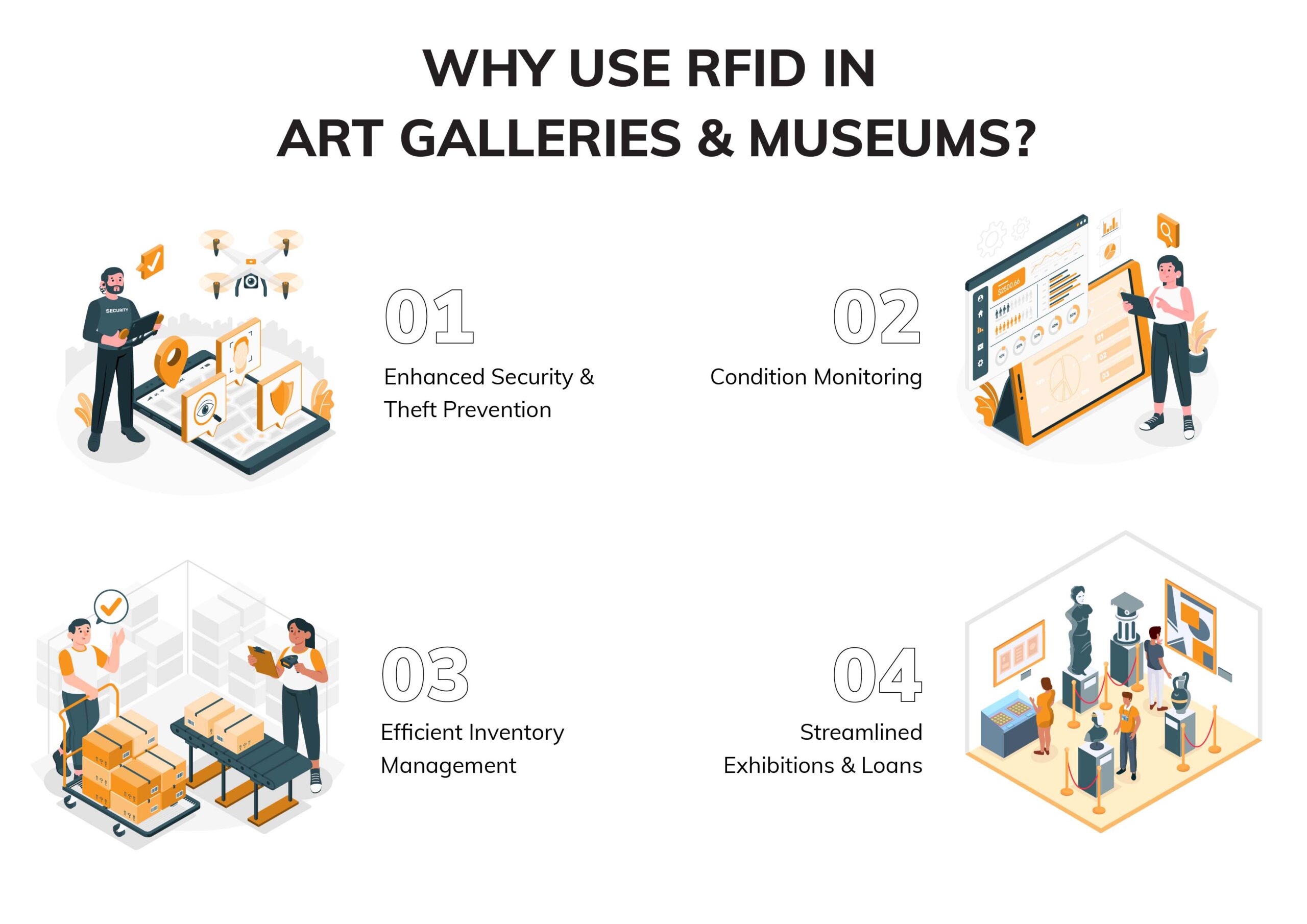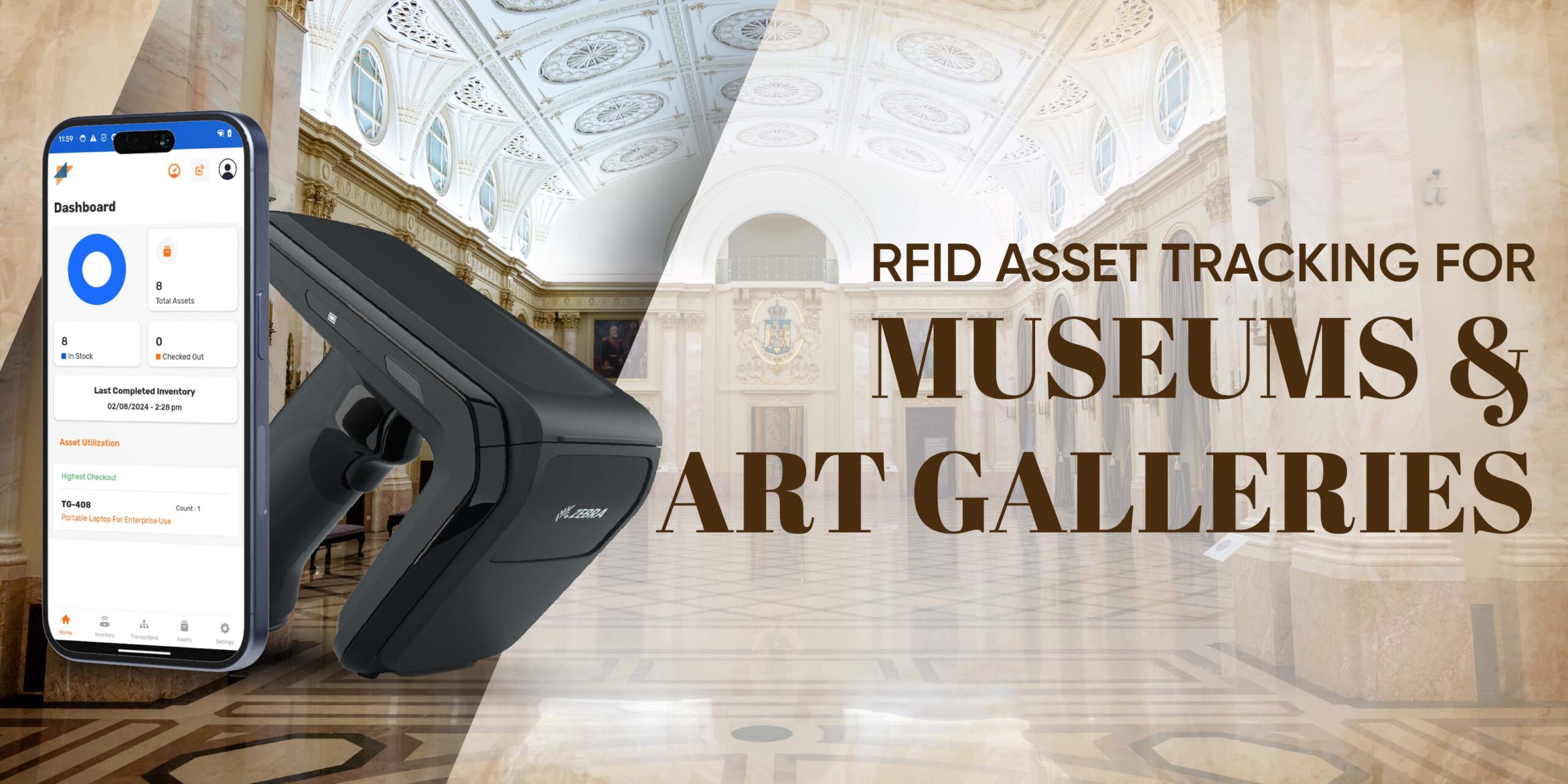In recent years, museums and art galleries have increasingly turned to Radio Frequency Identification (RFID) technology to revolutionize their asset tracking and management systems. This innovative approach offers numerous benefits, from enhanced security to improved inventory management and visitor experiences. Art galleries and museums house invaluable collections of art, artifacts, and historical items, making the security and accurate management of these assets a top priority.
(RFID) technology has emerged as a powerful tool for improving asset tracking in these environments. By providing real-time monitoring, RFID ensures that curators, collectors, and managers can safeguard their collections and streamline inventory processes efficiently. This article delves into the benefits, challenges, and implementation of RFID in art galleries and museums for asset tracking.
Why Use RFID in Art Galleries and Museums?
Art collections are often worth millions of dollars, both in terms of their monetary and cultural value. Ensuring the security and proper management of these assets is crucial. RFID offers several advantages that make it well-suited for tracking and managing assets in galleries and museums.
1. Enhanced Security and Theft Prevention in Art Galleries and Museums
Art theft is a serious concern for museums and galleries. Traditional methods of protecting assets, such as CCTV and manual inventory checks, are limited in their ability to prevent theft or detect unauthorized movement of items. RFID technology allows for real-time tracking of art pieces. RFID tags attached to artwork can trigger alarms if they are moved outside a designated area or if tampered with. This helps you prevent unauthorized access or theft, significantly enhancing security.
Moreover, RFID systems can be integrated with existing security measures such as surveillance cameras, motion detectors, and alarms, providing a comprehensive security framework in art galleries and museums. Should an artwork leave a restricted zone, the system can immediately notify security personnel, allowing for quick responses to potential threats.
2. Efficient Inventory Management in Art Galleries and Museums
Manual inventory processes in galleries and museums are time-consuming and prone to human error in the floor area of art galleries. The museum/art galleries floor plan is essential for organizing the physical features of the space. It helps architects and designers allocate areas for different exhibits, ensuring a smooth flow for visitors. Conducting physical inventories requires the handling of delicate objects, which increases the risk of damage. RFID systems, on the other hand, offer a non-invasive, efficient way to conduct regular inventories. Curators can simply use RFID readers to scan entire rooms, receiving instant updates on the location and status of each tagged item.
Additionally, the digital records created by RFID technology allow for more accurate and detailed tracking. This not only reduces the likelihood of loss or misplacement but also simplifies the loan process when pieces are shared with other institutions.
3. Condition Monitoring in Art Galleries and Museums
Artworks and historical artifacts are often fragile and sensitive to environmental conditions such as temperature, humidity, and light. RFID systems can be integrated with environmental sensors to monitor the conditions surrounding an artwork. This ensures that the objects are stored and displayed under optimal conditions, preventing degradation over time.
For instance, if a specific room’s humidity levels rise beyond the acceptable range, the RFID system can alert staff immediately, allowing them to take corrective action to protect the items.
4. Streamlined Exhibitions and Locations in Art Galleries and Museums
Museums and galleries frequently lend artworks to other institutions for temporary exhibitions. Keeping track of these loans can be challenging, especially when dealing with large collections. RFID technology helps track the location of each piece during the transportation and exhibition process. This ensures that all parties involved in the loan are aware of the current status of the artwork and its condition at all times.
RFID tags can also store essential information about the piece’s provenance, care requirements, and exhibit history, allowing curators and conservators to access detailed records with ease.
Implementation in Museums and Art Galleries
1. Tagging of Artwork, Sculptures and etc.
Paintings, sculptures, and installations: These are the primary assets found in both galleries and museums. Artworks can be part of a permanent collection or temporary exhibitions. Museums often have a permanent collection that includes pieces they have purchased or received as gifts, while galleries may focus on selling artworks directly to collectors. Each artifact or artwork is fitted with a small, unobtrusive RFID tag. These tags can be customized to blend seamlessly with the object, ensuring they don’t detract from the aesthetic value.
2. Reader Installation and Hand-held RFID Reader in Museum & Art Gallery.
RFID readers are strategically placed throughout the museum or gallery. These can be mounted on walls, ceilings, or integrated into display cases. Handheld readers can be used to monitor the location of pieces, ensuring that they are displayed correctly and securely. This is particularly useful for galleries that rotate exhibitions frequently or loan artworks to other institutions.
3. Software integration in art galleries and museums.
A central RFID software system is implemented to manage the data collected from the RFID tags. This system interfaces with existing inventory and security databases.

Advantages of RFID in Museums and Galleries
1. Enhanced Security with RFID in Museums and Galleries
- Real-time tracking of assets: continuously monitor the location of valuable items in museums and galleries.
- Theft Prevention of Museum Assets: immediate alerts if an item moves outside its designated area.
- Authentication: Easily verify the authenticity of artworks.
2. Improved inventory management and tracking in museums.
- Automated Audits: Conduct quick and accurate inventory checks without manual counting.
- Location tracking: Easily locate items in storage or on display.
- Condition Monitoring: Some advanced RFID tags can monitor environmental conditions affecting artworks.
3. Streamlined Logistics in Museums and Galleries
- Exhibition Planning: simplify the process of planning and setting up new exhibitions.
- Loan Management: Track items loaned to other institutions more effectively.
4. Enhanced visitor and people experience in galleries.
- Interactive Displays: RFID can trigger audio guides or multimedia content when visitors approach exhibits.
- Personalized Tours: Track visitor movements to offer customized experiences and recommendations.
5. Data collection and analysis in galleries & museums.
- Visitor Behavior: analyze patterns in how many visitors interact with exhibits.
- Popular Exhibits: identify which artworks attract the most attention.
RFID Software for Asset tracking of items in Museums and Art Galleries
TagMatiks AT is a cloud-based RFID asset tracking platform that leverages various AIDC technologies for data collection and analysis for museums and art galleries. The technologies include RFID, barcodes, and more. TagMatiks AT is RFID software that improves the asset tracking process and eliminates manual entry errors using RFID in museums and art galleries for asset tracking. It keeps track of the full life cycle (Receiving to Consumed / Disposed) of your assets, including scheduled maintenance or repair.
Conclusion
RFID technology offers museums and art galleries a powerful tool for asset tracking and management. While there are challenges to implementation, the benefits in terms of security, efficiency, and enhanced visitor experiences make it an increasingly attractive option for cultural institutions worldwide. As technology continues to evolve, we can expect to see even more innovative applications in the future, further transforming how we preserve and interact with our cultural heritage.
